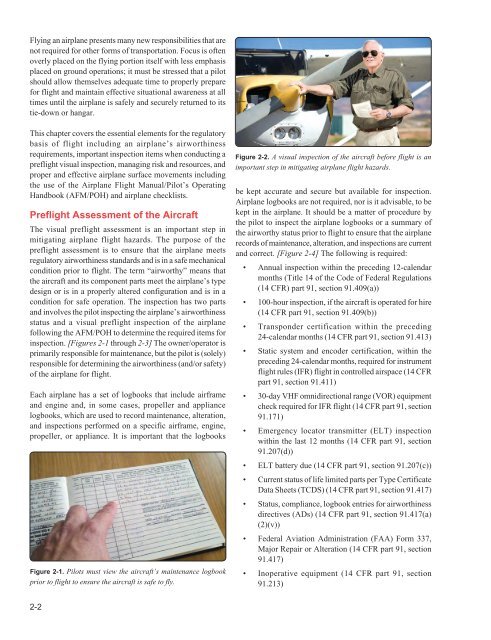Create successful ePaper yourself
Turn your PDF publications into a flip-book with our unique Google optimized e-Paper software.
<strong>Flying</strong> an airplane presents many new responsibilities that are<br />
not required for other forms of transportation. Focus is often<br />
overly placed on the flying portion itself with less emphasis<br />
placed on ground operations; it must be stressed that a pilot<br />
should allow themselves adequate time to properly prepare<br />
for flight and maintain effective situational awareness at all<br />
times until the airplane is safely and securely returned to its<br />
tie-down or hangar.<br />
This chapter covers the essential elements for the regulatory<br />
basis of flight including an airplane’s airworthiness<br />
requirements, important inspection items when conducting a<br />
preflight visual inspection, managing risk and resources, and<br />
proper and effective airplane surface movements including<br />
the use of the <strong>Airplane</strong> Flight Manual/Pilot’s Operating<br />
<strong>Handbook</strong> (AFM/POH) and airplane checklists.<br />
Preflight Assessment of the Aircraft<br />
The visual preflight assessment is an important step in<br />
mitigating airplane flight hazards. The purpose of the<br />
preflight assessment is to ensure that the airplane meets<br />
regulatory airworthiness standards and is in a safe mechanical<br />
condition prior to flight. The term “airworthy” means that<br />
the aircraft and its component parts meet the airplane’s type<br />
design or is in a properly altered configuration and is in a<br />
condition for safe operation. The inspection has two parts<br />
and involves the pilot inspecting the airplane’s airworthiness<br />
status and a visual preflight inspection of the airplane<br />
following the AFM/POH to determine the required items for<br />
inspection. [Figures 2-1 through 2-3] The owner/operator is<br />
primarily responsible for maintenance, but the pilot is (solely)<br />
responsible for determining the airworthiness (and/or safety)<br />
of the airplane for flight.<br />
Each airplane has a set of logbooks that include airframe<br />
and engine and, in some cases, propeller and appliance<br />
logbooks, which are used to record maintenance, alteration,<br />
and inspections performed on a specific airframe, engine,<br />
propeller, or appliance. It is important that the logbooks<br />
Figure 2-1. Pilots must view the aircraft’s maintenance logbook<br />
prior to flight to ensure the aircraft is safe to fly.<br />
Figure 2-2. A visual inspection of the aircraft before flight is an<br />
important step in mitigating airplane flight hazards.<br />
be kept accurate and secure but available for inspection.<br />
<strong>Airplane</strong> logbooks are not required, nor is it advisable, to be<br />
kept in the airplane. It should be a matter of procedure by<br />
the pilot to inspect the airplane logbooks or a summary of<br />
the airworthy status prior to flight to ensure that the airplane<br />
records of maintenance, alteration, and inspections are current<br />
and correct. [Figure 2-4] The following is required:<br />
• Annual inspection within the preceding 12-calendar<br />
months (Title 14 of the Code of Federal Regulations<br />
(14 CFR) part 91, section 91.409(a))<br />
• 100-hour inspection, if the aircraft is operated for hire<br />
(14 CFR part 91, section 91.409(b))<br />
• Transponder certification within the preceding<br />
24-calendar months (14 CFR part 91, section 91.413)<br />
• Static system and encoder certification, within the<br />
preceding 24-calendar months, required for instrument<br />
flight rules (IFR) flight in controlled airspace (14 CFR<br />
part 91, section 91.411)<br />
• 30-day VHF omnidirectional range (VOR) equipment<br />
check required for IFR flight (14 CFR part 91, section<br />
91.171)<br />
• Emergency locator transmitter (ELT) inspection<br />
within the last 12 months (14 CFR part 91, section<br />
91.207(d))<br />
• ELT battery due (14 CFR part 91, section 91.207(c))<br />
• Current status of life limited parts per Type Certificate<br />
Data Sheets (TCDS) (14 CFR part 91, section 91.417)<br />
• Status, compliance, logbook entries for airworthiness<br />
directives (ADs) (14 CFR part 91, section 91.417(a)<br />
(2)(v))<br />
• Federal Aviation Administration (FAA) Form 337,<br />
Major Repair or Alteration (14 CFR part 91, section<br />
91.417)<br />
• Inoperative equipment (14 CFR part 91, section<br />
91.213)<br />
2-2


